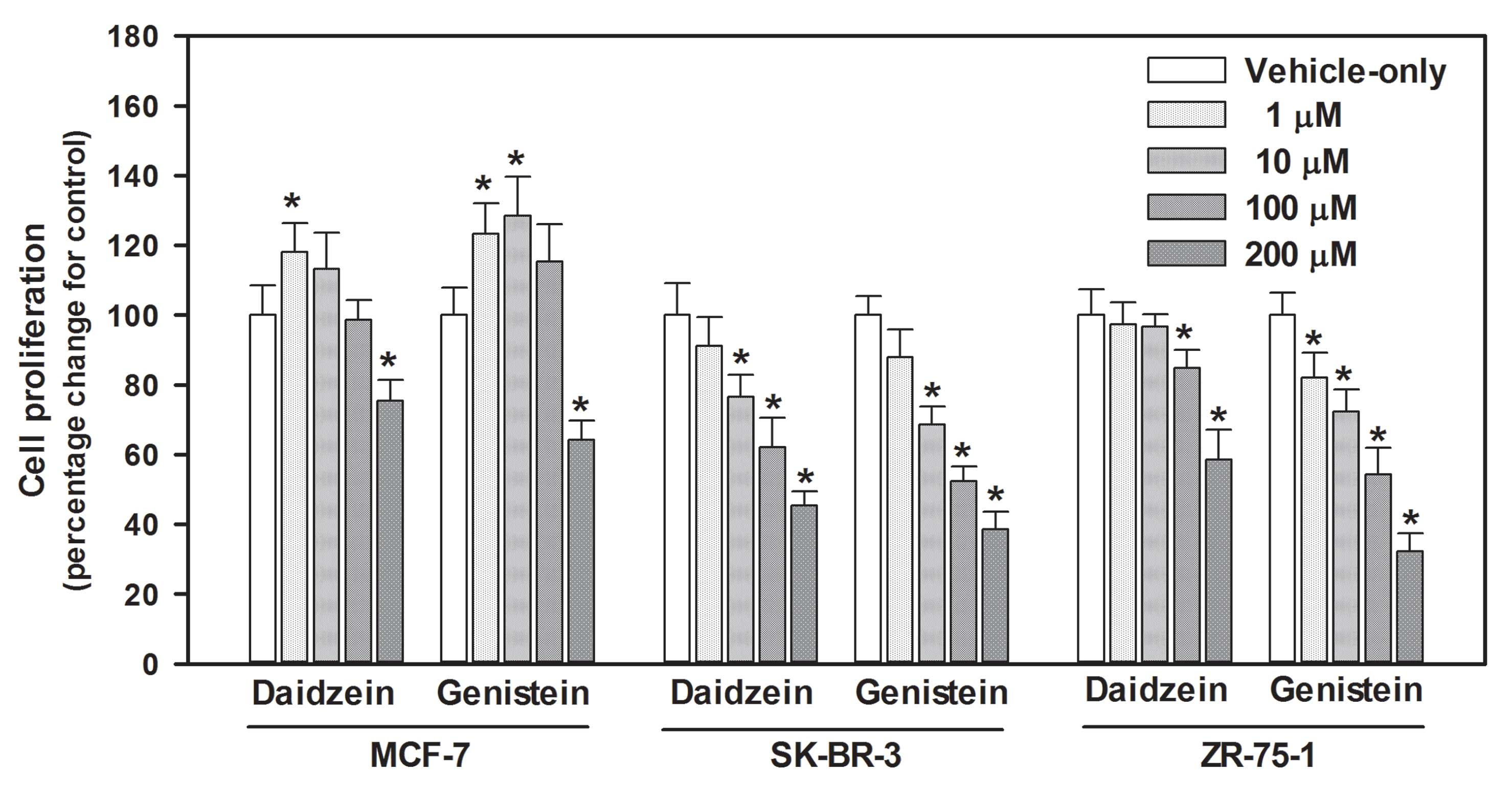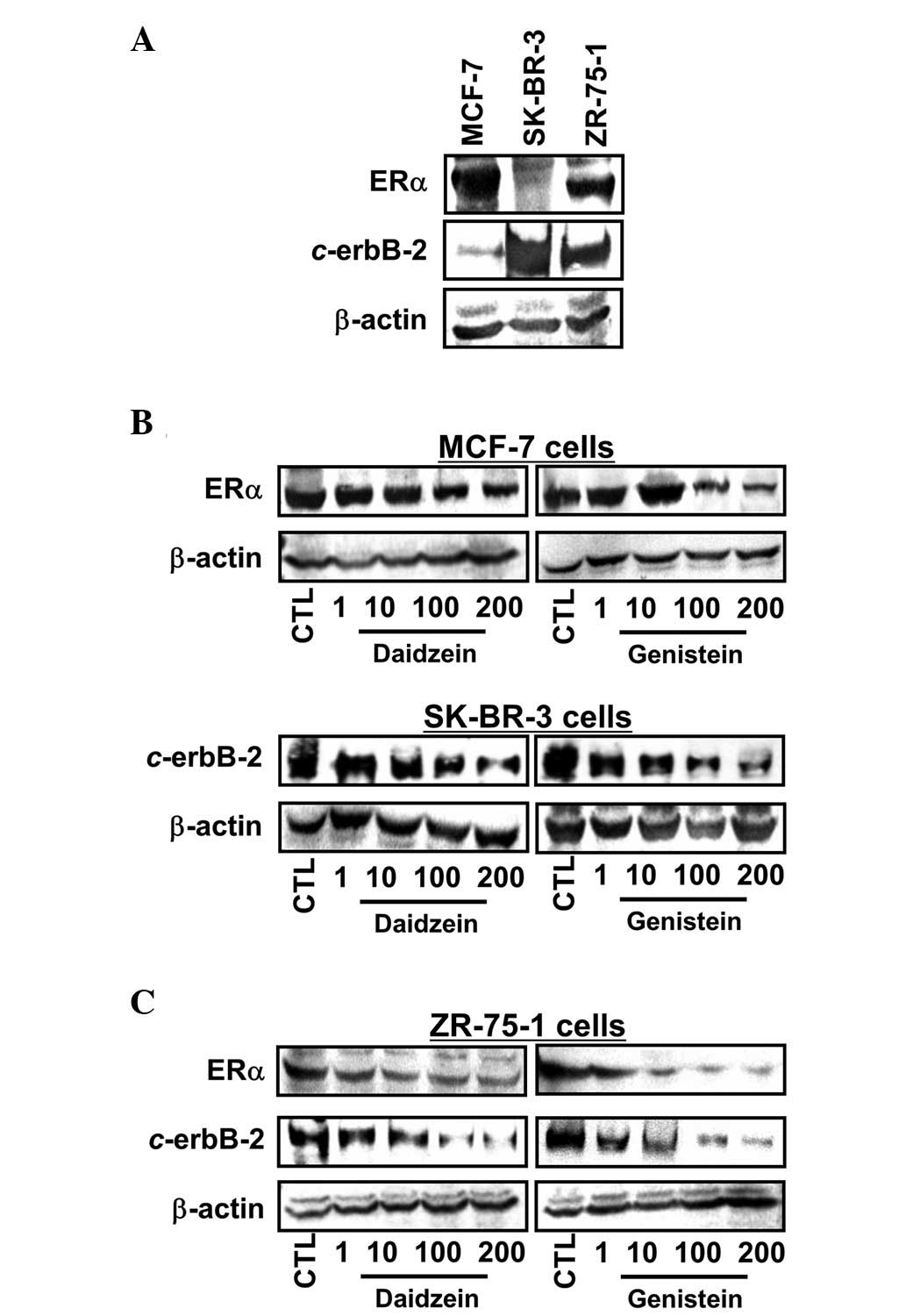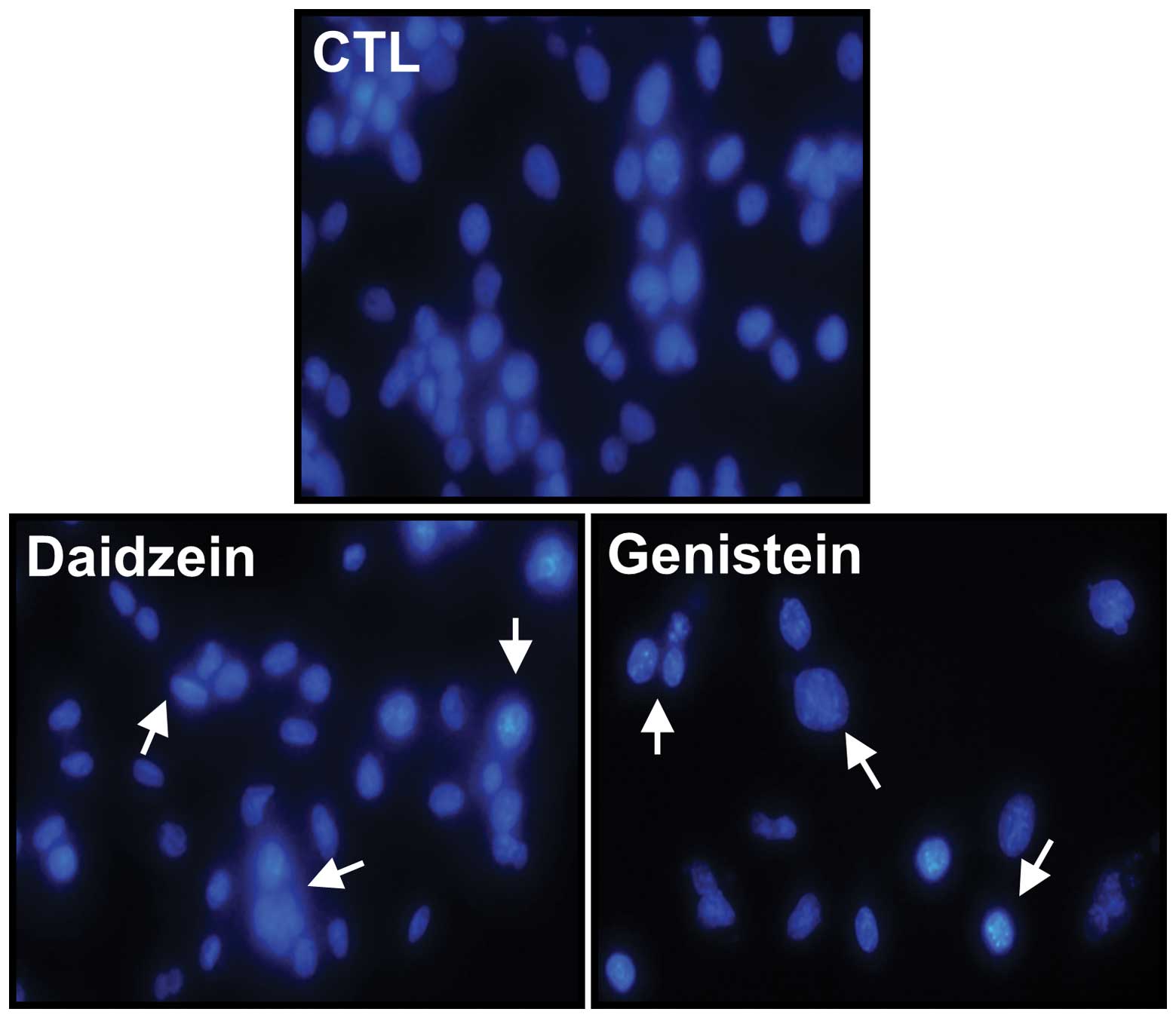Antiproliferative activity of daidzein and genistein may be related to ERα/c-erbB-2 expression in human breast cancer cells
- Authors:
- Published online on: January 21, 2013 https://doi.org/10.3892/mmr.2013.1283
- Pages: 781-784
Abstract
Introduction
Isoflavones are a flavonoid subclass that includes daidzein (7,4-dihydroxyisoflavone) and genistein (4′,5,7-trihydroxyisoflavone), which are the predominant isoflavones in legumes, such as soybeans, and are commonly found in a variety of human foods (1,2). Several epidemiological studies have revealed an inverse association between isoflavone consumption and the risk of breast cancer in Asians, indicating that dietary intervention may reduce the risk of breast cancer (3–5).
Based on this hypothesis, a number of studies have investigated the pharmacological activities of isoflavones as candidate anticancer agents. Many have reported that isoflavones significantly inhibit breast cancer cell growth in vitro(6–8), and that this growth inhibition stimulates the signal transduction pathway leading to apoptosis. Moreover, our previous studies support the theory that isoflavones, including genistein and daidzein, exhibit anticancer activity against breast cancer both in vivo(9,10) and in vitro(11,12).
Breast cancer is one of the cancers most frequently diagnosed in women. According to a US National Cancer Institute (NCI) report, one in eight women in the US (~13.3%) will develop breast cancer during their lifetime (13,14). Breast cancer is a group of heterogeneous diseases that manifest in several clinical, molecular and histopathological forms; this makes effective chemotherapy difficult. The response to a cancer drug may differ according to biological factors including estrogen receptor (ER) status, progesterone receptor status and c-erbB-2 expression. The present study compared the anticancer activity of daidzein and genistein via their effect on ERα and c-erbB-2 expression in breast cancer cell lines.
Materials and methods
Cell culture
Human breast cancer MCF-7, SK-BR-3 and ZR-75-1 cell lines were purchased from the KCLB (Korean Cell Line Bank, Seoul, Korea) and were used in the present study. Each cell line was routinely maintained in RPMI-1640 medium (Invitrogen, Carlsbad, CA, USA) supplemented with 10% fetal bovine serum (FBS) and antibiotics (50 U/ml penicillin and 50 μg/ml streptomycin; Gibco, Carlsbad, CA, USA) at 37°C in a humidified atmosphere containing 5% CO2. Each cell type was plated at a density of 0.8–1.2×106 cells/well and 2.5–5.0×103 cells/well on 6- and 96-well plates for 3-(4,5-dimethylthiazol-2-yl)-2,5-diphenyltetrazolium bromide (MTT) and immunoblotting assays, respectively. Daidzein and genistein were purchased from LC Laboratories® (Woburn, MA, USA) and dissolved in dimethyl sulfoxide (DMSO; final concentration 0.1% in medium).
MTT assay
Each cell type was exposed to daidzein or genistein at 1, 10, 100 and 200 μM for 72 h. Following treatment, the plated cells were incubated with MTT (0.5 mg/ml final concentration) for 4 h at 37°C. After discarding the medium from the plates, 100 μl DMSO was added to each well. The plates were placed for 5 min at room temperature with agitation, so that complete dissolution of formazan was achieved. The absorbance of the MTT formazan was determined at 540 nm by a UV/VIS spectrophotometric plate reader (Emax; Molecular Devices, Silicon Valley, CA, USA).
Immunoblotting assay
Each cell type was exposed to daidzein or genistein at 1, 10, 100 and 200 μM for 72 h. Cells were lysed in RIPA buffer (1% NP-40, 150 mM NaCl, 0.05% DOC, 1% SDS, 50 mM Tris, pH 7.5) containing protease inhibitor for 1 h at 4°C. The supernatant was separated by centrifugation and the protein concentration was determined by Bradford protein assay kit II (Bio-Rad Laboratories, Hercules, CA, USA). Proteins were transferred onto nitrocellulose membranes (0.45 μm). The membranes were blocked with a 1% bovine serum albumin (BSA) solution for 1.5 h and washed twice with phosphate-buffered saline (PBS) containing 0.2% Tween-20 and incubated with the respective primary antibodies (ERα, C-erbB-2, β-actin; Santa Cruz Biotechnology, Inc., Santa Cruz, CA, USA) overnight at 4°C. The next day, the immunoreaction was continued with the secondary rabbit anti-rabbit horseradish peroxidase-conjugated antibody after washing for 2 h at room temperature. The specific protein bands were detected using an Opti-4CN Substrate kit (Bio-Rad Laboratories).
Apoptosis detection
Apoptotic morphological changes were determined by DAPI (4′,6-diamidino-2-phenyl-indole) staining on ZR-75-1 cells exposed to daidzein or genistein at a concentration of 100 μM for 72 h. After harvesting the cells exposed to daidzein or genistein, the cells were seeded onto poly-l-lysine-coated slides and fixed with 4% methanol-free formaldehyde solution for 30 min. Mounting medium with DAPI (Molecular Probes, Invitrogen) was then dispersed over the entire section of slides. Mounted slides were stored at 4°C without light. Each slide was observed under an Axio vision 4.0 fluorescence microscope (Carl Zeiss Inc., New York, NY, USA).
Statistical analysis
The values are expressed as the means ± standard deviation (SD). Data were analyzed by unpaired Student’s t-test or one-way analysis of variance followed by Dunnett’s multiple comparison test (SigmaStat, San Jose, CA, USA). P<0.05 was considered to indicate a statistically significant difference.
Results
Antiproliferative activities
We compared the antiproliferative effects of daidzein and genistein on MCF-7, SK-BR-3 and ZR-75-1 cells (Fig. 1). Exposure of MCF-7 cells to various concentrations (1, 10, 100 and 200 μM) of daidzein and genistein for 72 h resulted in similar biphasic antiproliferative effects. Although daidzein and genistein at higher concentrations (200 μM) inhibited proliferation by 24.64 and 35.79%, respectively, compared with the control, both compounds stimulated cell growth at lower concentrations (<10 μM). Daidzein and genistein (1 and 10 μM, respectively) induced cell growth by ~18 and 28%, respectively.
The two compounds greatly inhibited growth of SK-BR-3 cells in a dose-dependent manner. Statistically significant inhibition of cell proliferation was first observed in cells treated with 10 μM daidzein and genistein (23.46 and 35.79% inhibition, respectively). The IC50 values for daidzein and genistein were 211.70 and 138.13 μM, respectively.
In ZR-75-1 cells, the antiproliferative effects of genistein were stronger than those of daidzein under the same conditions. Genistein significantly inhibited proliferation of ZR-75-1 cells in a dose-dependent manner; the effect was similar to that of genistein on SK-BR-3 cells. Daidzein significantly inhibited cell growth at 100 and 200 μM, but not at concentrations <10 μM. Inhibition of proliferation by higher daidzein concentrations was decreased by 15–41% compared with control levels.
ERα and c-erbB-2 expression
ERα and c-erbB-2 expression was determined in the three cell lines (Fig. 2A). ERα-positive MCF-7 cells exhibited a basal level of c-erbB-2, while SK-BR-3 cells overexpressed c-erbB-2. In ZR-75-1 cells, expression of ERα and c-erbB-2 was observed. As presented in Fig. 2B and C, when cells were exposed to 1, 10, 100 and 200 μM daidzein and genistein for 72 h, ERα expression by MCF-7 cells exposed to genistein showed a pattern similar to the antiproliferative effects and no stimulation by lower daidzein concentrations was detected. However, both daidzein and genistein reduced ERα expression at higher concentrations (100 and 200 μM). Notably, ERα expression in ZR-75-1 cells was downregulated by daidzein and genistein at the concentrations used; again, the effect of genistein was greater. c-erbB-2 expression was decreased by daidzein and genistein in a dose-dependent manner in SK-BR-3 and ZR-75-1 cells, regardless of their basal c-erbB-2 levels.
Apoptosis induction
DAPI staining was used to detect apoptotic changes after exposing ZR-75-1 cells to either daidzein or genistein at a concentration of 100 μM for 72 h (Fig. 3). Apoptotic morphological features, such as cell shrinkage and dot-shaped nuclear fragments, were observed following exposure of cells to daidzein and genistein. Compared with control cells, exposure to genistein resulted in a marked increase in apoptotic morphological features.
Discussion
In this study, we investigated the antiproliferative effects of the isoflavones daidzein and genistein in the following three breast cancer cell lines: MCF-7 (ERα+), SK-BR-3 (c-erbB-2++) and ZR-75-1 (ERα+ and c-erbB-2+).
The effects differed greatly according to breast cancer cell type. Daidzein and genistein exhibited a significant antiproliferative effect against the three cell lines, however, the effect on MCF-7 cells was biphasic (inhibitory at high concentrations and stimulatory at low concentrations). This is consistent with previous studies that revealed isoflavones exert a biphasic effect on cell proliferation (15–17), which may be explained by their estrogen-like activity. Isoflavones are known as phytoestrogens, which are molecules structurally similar to 17β-estradiol (18). This characteristic may cause not only ER-agonistic but also ER-antagonistic effects and was likely responsible for the biphasic effect on MCF-7 cell proliferation. This mechanism may prove useful in the prevention of ER-positive breast cancer. ERα is a member of the steroid receptor superfamily and regulates growth, differentiation and other processes in various target cells by regulating transcriptional processes (19). It is also important in the development and progression of breast cancer (20) and is expressed in ~70% of breast cancers (21), which makes it difficult to obtain a response to cancer drug treatment.
By contrast, daidzein and genistein significantly inhibited the growth of SK-BR-3 and ZR-75-1 cells in a dose-dependent manner under the same conditions; however, the antiproliferative effects of daidzein were relatively weak. Genistein had a stronger effect on ERα-positive SK-BR-3 cells than ERα- and c-erbB-2-positive ZR-75-1 cells; the IC50 values were 138.13 and 127.71 μM in SK-BR-3 and ZR-75-1 cells, respectively. c-erbB-2 (HER2/neu) encodes a 185-kDa transmembrane glycoprotein that belongs to the epidermal growth factor receptor family of type I receptor tyrosine kinases (ErbB family). c-erbB-2 overexpression has been reported in ~25–30% of human breast cancers (22,23). Overall, genistein exhibited an effect on the three cell lines; the gap between stimulation and inhibition of proliferation of MCF-7 cells exposed to genistein was larger than that of daidzein and the antiproliferative effects on the other cell lines were more marked. This may be due to the estrogenic activity of genistein, which has a stronger affinity for ERs than daidzein (12).
Moreover, when cell lines were exposed to daidzein and genistein under the same conditions, the modulation of ERα and c-erbB-2 expression by daidzein and genistein reflected their pattern of antiproliferative activity. Induction of ERα expression in MCF-7 cells exposed to <10 μM daidzein was unclear; at higher concentrations, daidzein downregulated the ERα expression. ER expression in ZR-75-1 cells was also slightly reduced by daidzein, regardless of dose. Similar to the pattern of MCF-7 cell proliferation by genistein, its application at a lower concentration stimulated ERα expression; by contrast, genistein at a higher concentration markedly reduced this expression. This reduction was also observed in ZR-75-1 cells exposed to genistein, even at a lower concentration (1 μM).
c-erbB-2 expression by SK-BR-3 and ZR-75-1 cells was decreased by daidzein or genistein, with the latter having a greater effect. It has been reported that the mechanism underlying the anticancer activity of genistein and daidzein involves downregulation of c-erbB-2 (24,25) and enhanced ER-erbB-2 cross-talk in breast cancer cells (26).
The isoflavones daidzein and genistein induced apoptosis as evidenced by the apoptotic morphological features that were observed in cells exposed to daidzein and genistein. Several studies have indicated that anticancer drugs or cancer chemopreventive agents act through the induction of apoptosis in various cancer cells (27,28). Recently, the regulation of apoptosis has been proposed as a promising target for cancer chemotherapy. Our data suggest that daidzein and genistein may possess anticancer properties.
Based on our results, although both daidzein and genistein may be deleterious at lower concentrations by stimulating proliferation of MCF-7 cells, genistein may offset those effects and could be beneficial for breast cancer prevention under certain conditions. Genistein at higher concentrations had a marked anti-estrogenic effect via ERα-downregulation and the growth-promotion effect of genistein was attenuated in ERα and c-erbB-2-coexpressing ZR-75-1 cells via downregulation of c-erbB-2.
Acknowledgements
This study was supported by the Basic Research Program through the National Research Foundation of Korea (NRF) funded by the Ministry of Education, Science and Technology (2012-0006811 and 2012-041653).
References
|
Liggins J, Bluck LJ, Runswick S, et al: Daidzein and genistein contents of vegetables. Br J Nutr. 84:717–725. 2000.PubMed/NCBI | |
|
Liggins J, Bluck LJ, Runswick S, et al: Daidzein and genistein content of fruits and nuts. J Nutr Biochem. 11:326–331. 2000. View Article : Google Scholar : PubMed/NCBI | |
|
Iwasaki M, Inoue M, Otani T, et al: Plasma isoflavone level and subsequent risk of breast cancer among Japanese women: a nested case-control study from the Japan Public Health Center-based prospective study group. J Clin Oncol. 26:1677–1683. 2008. View Article : Google Scholar | |
|
Lampe JW, Nishino Y, Ray RM, et al: Plasma isoflavones and fibrocystic breast conditions and breast cancer among women in Shanghai, China. Cancer Epidem Biomarkers Prev. 16:2579–2586. 2007. View Article : Google Scholar : PubMed/NCBI | |
|
Lu LJ, Anderson KE, Grady JJ, et al: Decreased ovarian hormones during a soya diet: implications for breast cancer prevention. Cancer Res. 60:4112–4121. 2000.PubMed/NCBI | |
|
Vissac-Sabatier C, Bignon YJ and Bernard-Gallon DJ: Effects of the phytoestrogens genistein and daidzein on BRCA2 tumor suppressor gene expression in breast cell lines. Nutr Cancer. 45:247–255. 2003. View Article : Google Scholar : PubMed/NCBI | |
|
de Lemos ML: Effects of soy phytoestrogens genistein and daidzein on breast cancer growth. Ann Pharmacother. 35:1118–1121. 2001.PubMed/NCBI | |
|
Pugazhendhi D, Watson KA, Mills S, et al: Effect of sulphation on the oestrogen agonist activity of the phytoestrogens genistein and daidzein in MCF-7 human breast cancer cells. J Endocrinol. 197:503–515. 2008. View Article : Google Scholar : PubMed/NCBI | |
|
Choi EJ and Kim GH: Hepatoprotective effects of daidzein against 7,12-dimetylbenz[a]anthracene-induced oxidative stress in mice. Int J Mol Med. 23:659–664. 2009.PubMed/NCBI | |
|
Choi EJ and Lee BH: Evidence for genistein mediated cytotoxicity and apoptosis in rat brain. Life Sci. 75:499–509. 2004. View Article : Google Scholar : PubMed/NCBI | |
|
Choi EJ, Kim T and Lee MS: Pro-apoptotic effect and cytotoxicity of genistein and genistin in human ovarian cancer SK-OV-3 cells. Life Sci. 80:1403–1408. 2007. View Article : Google Scholar : PubMed/NCBI | |
|
Choi EJ and Kim GH: Daidzein causes cell cycle arrest at the G1 and G2/M phases in human breast cancer MCF-7 and MDA-MB-453 cells. Phytomedicine. 15:683–690. 2008. View Article : Google Scholar : PubMed/NCBI | |
|
National Breast Cancer Foundation. http://www.nationalbreastcancer.org/about-breast-cancer/breast-cancer-symptoms. Accessed, March 2011 | |
|
National Cancer Institute. SEER Cancer Statistics Review, 1975–2002. http://seer.cancer.gov/csr/1975_2002/. Accessed, March 2005 | |
|
Guo JM, Xiao BX, Liu DH, et al: Biphasic effect of daidzein on cell growth of human colon cancer cells. Food Chem Toxicol. 42:1641–1646. 2004. View Article : Google Scholar : PubMed/NCBI | |
|
El Touny LH and Banerjee PP: Identification of a biphasic role for genistein in the regulation of prostate cancer growth and metastasis. Cancer Res. 69:3695–3703. 2009.PubMed/NCBI | |
|
Hsu JT, Hung HC, Chen CJ, et al: Effects of the dietary phytoestrogen biochanin A on cell growth in the mammary carcinoma cell line MCF-7. J Nutr Biochem. 10:510–517. 1999. View Article : Google Scholar : PubMed/NCBI | |
|
Sirtori CR, Arnoldi A and Johnson SK: Phytoestrogens: end of a tale? Ann Med. 37:423–438. 2005. View Article : Google Scholar : PubMed/NCBI | |
|
Björnström L and Sjöberg M: Mechanisms of estrogen receptor signaling: convergence of genomic and nongenomic actions on target genes. Mol Endocrinol. 19:833–842. 2005.PubMed/NCBI | |
|
Sperelakis N: Properties of calcium channels in cardiac muscle and vascular smooth muscle. Mol Cell Biochem. 99:97–109. 1990. View Article : Google Scholar : PubMed/NCBI | |
|
Plaza-Menacho I, Morandi A, Robertson D, Pancholi S, et al: Targeting the receptor tyrosine kinase RET sensitizes breast cancer cells to tamoxifen treatment and reveals a role for RET in endocrine resistance. Oncogene. 29:4648–4657. 2010. View Article : Google Scholar : PubMed/NCBI | |
|
Slamon DJ, Clark GM, Wong SG, et al: Human breast cancer: correlation of relapse and survival with amplification of the HER-2/neu oncogene. Science. 235:177–182. 1987. View Article : Google Scholar : PubMed/NCBI | |
|
Slamon DJ, Godolphin W, Jones LA, et al: Studies of the HER-2/neu proto-oncogene in human breast and ovarian cancer. Science. 244:707–712. 1989. View Article : Google Scholar : PubMed/NCBI | |
|
Li Y, Bhuiyan M and Sarkar FH: Induction of apoptosis and inhibition of c-erbB-2 in MDA-MB-435 cells by genistein. Int J Oncol. 15:525–533. 1999.PubMed/NCBI | |
|
Kim EJ, Shin HK and Park JH: Genistein inhibits insulin-like growth factor-I receptor signaling in HT-29 human colon cancer cells: a possible mechanism of the growth inhibitory effect of Genistein. J Med Food. 8:431–438. 2005. View Article : Google Scholar : PubMed/NCBI | |
|
Yang X, Yang S, McKimmey C, et al: Genistein induces enhanced growth promotion in ER-positive/erbB-2-overexpressing breast cancers by ER-erbB-2 cross talk and p27/kip1 downregulation. Carcinogenesis. 31:695–702. 2010. View Article : Google Scholar : PubMed/NCBI | |
|
Grimm D, Wehland M, Pietsch J, et al: Drugs interfering with apoptosis in breast cancer. Curr Pharm Des. 17:272–283. 2011. View Article : Google Scholar : PubMed/NCBI | |
|
Jin FP and Zhang M: Progress of experimental researches on Chinese herbal compounds for inducing tumor cell apoptosis. Chin J Integr Med. 16:565–571. 2010. View Article : Google Scholar : PubMed/NCBI |












